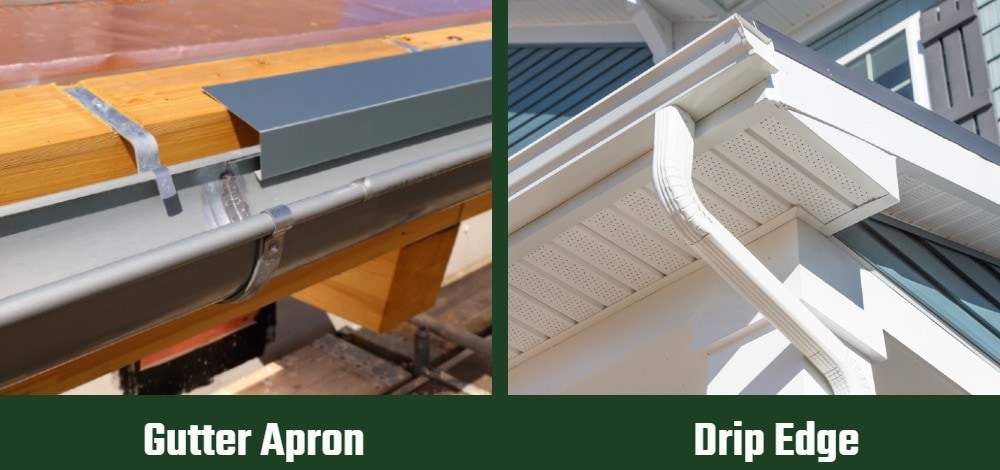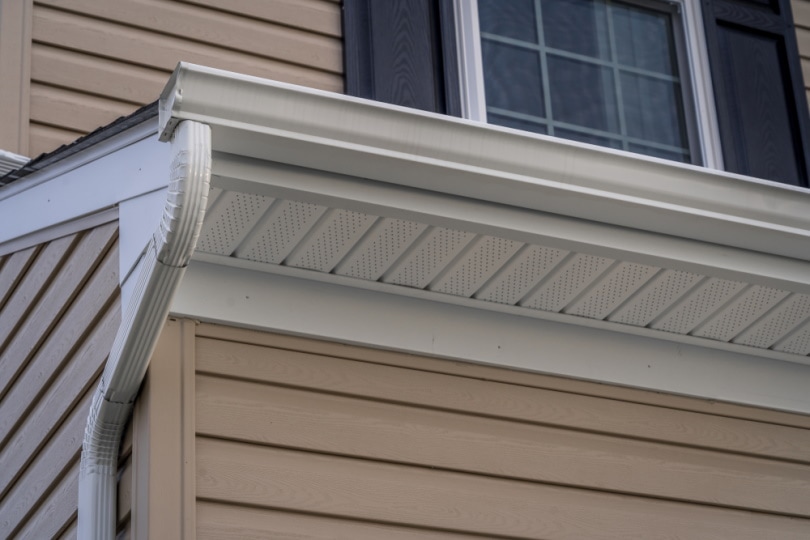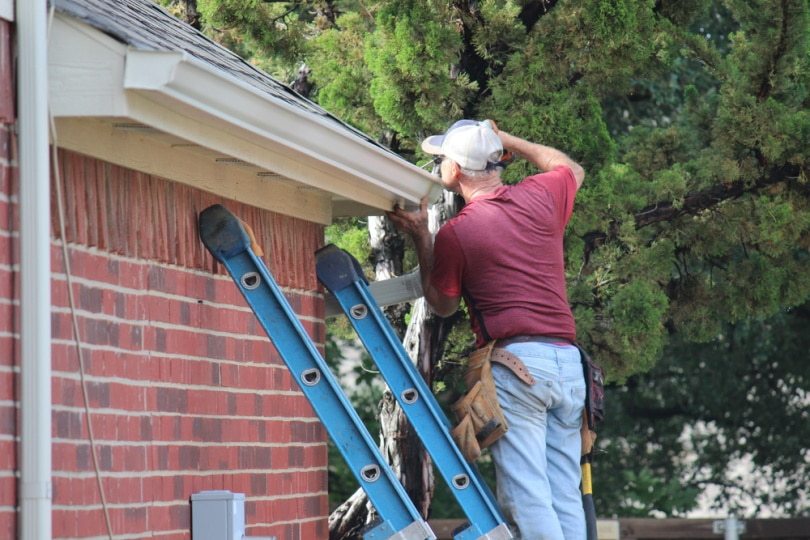Gutter Apron vs. Drip Edge: Pros, Cons & Cost
-
Caroline Bonin
- Last updated:

The task of a gutter is simple enough: to direct water away from your house. Gutters protect your roof and walls from water damage by catching rainfall and diverting it through downspouts and onto the ground.
Gutters are only one part of your roof’s protection system. Another lesser-known but equally important component is metal flashing. Flashing is a thin layer of metal sheeting that directs water away from vital areas of your roof, such as seams and joints where moisture could seep in and cause insidious damage.
A gutter apron and drip edges are two types of flashing that are designed to protect the edge of your roof, where the shingles come to an end. They both prevent water from flowing under your shingles—but what’s the difference between them?
We’ll take a close look at the options and give you all the information you need to pick the right one for you and your roof.
Overview of Drip Edge
A drip edge is a section of metal flashing installed along the edge of the roof that creates a watertight seal. It’s an important part of your home’s gutter system, but not all builders install it when the home is initially constructed. Some states now require your house to have a drip edge, while some simply recommend it.

What is a Drip Edge?
Drip edges are installed on the roof’s trim. Its bent design allows water to flow away from the roof and keeps moisture from getting underneath your shingles and into the fascia board, which could result in eventual mold and rot. The face of the drip edge needs to overlap the gutter in order to stop water from falling into the gaps.
When to Choose a Drip Edge
Every house should have flashing around the edge of the roof to prevent water damage. Drip edges are a simple solution and may be enough for your house.
A drip edge is especially important at the rake edges of your roof, though you may want them at the eaves as well. Storms with high winds can lift your shingles along the rake edges, exposing the fascia underneath to the rain. Drip edge flashing provide an extra layer of protection if this happens.
Pros and Cons of Drip Edges
Drip edge flashing has many benefits. These include:
- Protection against water damage, wind, and rot
- Preventing animals and insects from entering your home
- Support to shingles and roof edges
- Saving time and money in future repairs
It has a few drawbacks as well, including:
- Frequently not included in initial roof construction
- Can be difficult to install on an existing roof
- Can have code requirements
Typically the pros of having a drip edge installed outweigh the cons, but there are certain situations in which your house might not need a drip edge. For example, if you have aluminum fascia built into your home that already aligns with your roof edge, you may not need to install any additional flashing.
If you’re not sure, you can always have your roof evaluated by a professional or a friend with expertise.
Find a gutter specialist in your area, and get free, no-commitment estimates for your project.Consult a gutter installation expert

Overview of Gutter Aprons
Gutter aprons are a variation on drip edge flashing. They are folded at 120 degrees to direct water away from your shingles and into your gutter.
What is a Gutter Apron?
Gutter aprons are L-shaped pieces of metal that slide under your shingles and hang down an inch below the back of the gutter. Whereas standard drip edge attaches to the trim of your roof, gutter aprons are inserted further underneath your shingles, providing an additional layer of protection just under the surface of your roof.
They also come in larger dimensions than drip edge flashing, which can allow them greater reach when it comes to warding off the water.
When to Choose a Gutter Apron
Some roofing professionals consider gutter aprons a higher level of protection than drip edges. Depending on the yearly rainfall in your area and the quality of your roof, you may wish to opt for gutter aprons.
Gutter aprons are only necessary for the parts of the roof that have a gutter. If there are edges of your roof without a gutter attached, you will only need to install a drip edge along those sides.
The pros and cons of gutter aprons are similar to those of drip edge flashing. If you live in an area with a lot of rainfall or heavy storms, you may wish to invest in a gutter apron as they can add an increased degree of protection and as peace of mind.
They may also be the right choice if your shingles are low-quality or weren’t properly installed. A roofing technician can evaluate your roof and give you a more thorough assessment of what flashing is appropriate for your home.
What Materials Are Used for Roof Flashing?
Both gutter aprons and drip edge flashing are typically made from metals, though there are plastic options on the market too. Metal is usually recommended for its durability, resistance to corrosion, and aesthetic appearance.
- Aluminum: Aluminum is one of the cheaper options when you’re picking out your gutter aprons or drip edge. It’s also extremely malleable, which makes it ideal for the tricky sections of your roof, such as around your chimney or in valleys. Keep in mind is that you will need to add a finish to give it resistance to corrosive effects, such as rust.
- Galvanized Steel: Galvanized steel is a great choice for metal roofs as they’re usually made of similar materials, giving them a unified look. Most galvanized steel is coated with zinc, which means it will endure inclement weather hardily and sustain a longer lifespan.
- Lead: If you’re looking for flashings that you’ll never have to replace, lead is at the front of the pack. It’s said to last for at least 200 years. It’s a breathable metal that can expand and contract in different temperatures, lending it special versatility. However, due to the health and safety hazards associated with the material, you’ll need to be careful if you install lead flashings. If you already have them on your house and want to remove them, it may be best to hire a professional because lead needs to be handled and disposed of safely. If your existing lead flashings aren’t giving you trouble, you don’t necessarily need to replace them, as they won’t pose a risk to anyone living in your home.
- Copper: Copper is one of the most popular options because of its extreme durability and attractive look. It makes a striking feature on any house, especially older houses, and will develop a green patina over time instead of rust—just like the Statue of Liberty. It may be more expensive than some of the other options, so make sure to check the price tag before buying.
How Do You Install Roof Flashing?
The method of installation for roof flashing depends on what type you’ve chosen.
A drip edge needs to be installed on the edge of the roof trim so that it hangs behind the back end of the gutter. The pieces should be installed from the bottom of the rake upward, each slightly overlapping the one next to it to keep water from getting through.
Gutter aprons will need to be installed under the shingles or roofing material and above the decking.
If you want to install the flashing yourself, you will need a ladder, nails, and necessary tools to cut and attach the flashing to your roof. It is possible to complete this job on your own, but it can be a complicated procedure, which means you may wish to consider hiring a professional if you don’t feel confident doing it yourself.

The Cost Factor
Installing roof flashing is very affordable, with little to no difference in pricing between gutter aprons or drip edges. If you use aluminum or galvanized steel, the cost will come in at around $1 to $3 per linear foot of flashing. Copper is the more expensive choice, at $35 to $75 per 10 linear feet.
If you do decide to hire a professional to install your flashing for you, you will also be looking at labor costs. It’s a job that can be done in a day, with pricing ranging from $45 to $75 an hour. Contact your local roofing business to get an exact quote for your roof.
The Bottom Line
Flashing is an essential part of your roof’s protection system. Gutter aprons and drip edges are two types of flashing that will bolster the edge of your roof and keep moisture from seeping underneath your shingles. Both are effective options, though you may find one is better suited to your house based on its unique qualities. Either way, you’re making a reasonable but valuable investment into safeguarding your home for the long term.
Featured Image Credit: Left: Gutter Apron: Palatinate Stock, Shutterstock | Right: Drip Edge: tokar, Shutterstock
Contents
